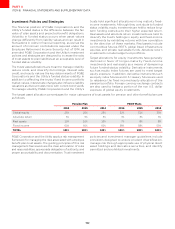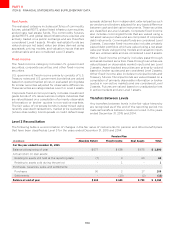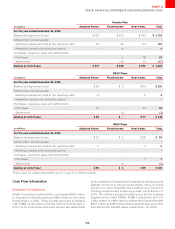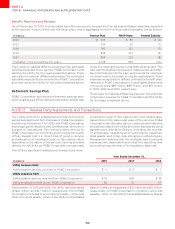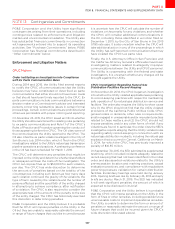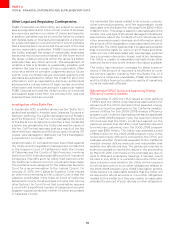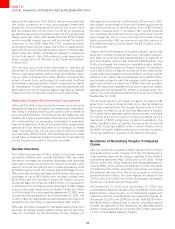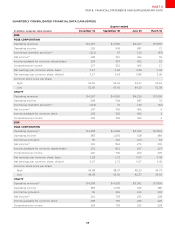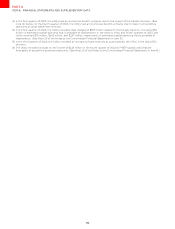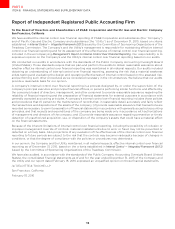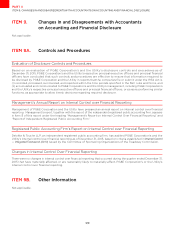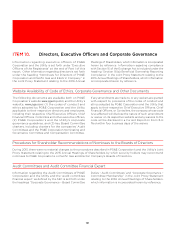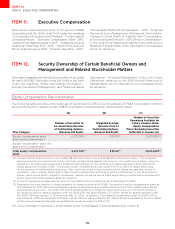PG&E 2015 Annual Report Download - page 120
Download and view the complete annual report
Please find page 120 of the 2015 PG&E annual report below. You can navigate through the pages in the report by either clicking on the pages listed below, or by using the keyword search tool below to find specific information within the annual report.
112
PART II
ITEM 8.FINANCIAL STATEMENTS AND SUPPLEMENTARY DATA
agencies for approval. The Utility’s design proposes that
the Utility construct an in-situ groundwater treatment
system to convert hexavalent chromium into a non-toxic
and non-soluble form of chromium. The DTSC is conducting
an additional environmental review of the proposed
design, and the Utility anticipates that the DTSC’s draft
environmental impact report will be issued for public
comment in July 2016. After the DTSC considers public
comments that may be made, the DTSC is expected to
issue a final environmental impact report in December
2016. After the Utility modifies its design in response
to the final report, the Utility plans to seek approval to
begin construction of the new in-situ treatment system
in early 2017.
The Utility’s environmental remediation liability at
December 31, 2015 reflects its best estimate of probable
future costs associated with its final remediation plan.
Future costs will depend on many factors, including the
extent of work to be performed to implement the final
groundwater remedy and the Utility’s required time frame
for remediation. Future changes in cost estimates and the
assumptions on which they are based may have a material
impact on future financial condition and cash flows.
Reasonably Possible Environmental Contingencies
Although the Utility has provided for known environmental
obligations that are probable and reasonably estimable,
the Utility’s undiscounted future costs could increase to
as much as $1.9 billion (including amounts related to the
Hinkley and Topock sites described above) if the extent
of contamination or necessary remediation is greater
than anticipated or if the other potentially responsible
parties are not financially able to contribute to these
costs. The Utility may incur actual costs in the future that
are materially dierent than this estimate and such costs
could have a material impact on results of operations
during the period in which they are recorded.
Nuclear Insurance
The Utility is a member of NEIL, which is a mutual insurer
owned by utilities with nuclear facilities. NEIL provides
insurance coverage for property damages and business
interruption losses incurred by the Utility if a nuclear event
were to occur at the Utility’s two nuclear generating units
at Diablo Canyon and the retired Humboldt Bay Unit 3.
NEIL provides property damage and business interruption
coverage of up to $3.5 billion per nuclear incident and
$2.8 billion per non-nuclear incident for Diablo Canyon.
Humboldt Bay Unit 3 has up to $131 million of coverage for
nuclear and non-nuclear property damages. If NEIL losses
in any policy year exceed accumulated funds, the Utility
could be subject to a retrospective assessment. If NEIL were
to exercise this assessment, as of December 31, 2015, the
current maximum aggregate annual retrospective premium
obligation for the Utility is approximately $60million.
NEIL also provides coverage for damages caused by acts of
terrorism at nuclear power plants. Certain acts of terrorism
may be “certified” by the Secretary of the Treasury. If
damages are caused by certified acts of terrorism, NEIL
can obtain compensation from the federal government
and will provide up to its full policy limit of $3.5 billion
for each insured loss. In contrast, NEIL would treat all
non-certified terrorist acts occurring within a 12-month
period against one or more commercial nuclear power
plants insured by NEIL as one event and the owners of
the aected plants would share the $3.5 billion policy
limit amount.
Under the Price-Anderson Act, public liability claims that
arise from nuclear incidents that occur at Diablo Canyon,
and that occur during the transportation of material to
and from Diablo Canyon are limited to $13.5 billion. The
Utility purchased the maximum available public liability
insurance of $375 million for Diablo Canyon. The balance
of the $13.5 billion of liability protection is provided under
a loss-sharing program among utilities owning nuclear
reactors. The Utility may be assessed up to $255 million
per nuclear incident under this program, with payments in
each year limited to a maximum of $38 million per incident.
Both the maximum assessment and the maximum yearly
assessment are adjusted for inflation at least every five
years. The next scheduled adjustment is due on or before
September 10, 2018.
The Price-Anderson Act does not apply to claims that
arise from nuclear incidents that occur during shipping
of nuclear material from the nuclear fuel enricher to a fuel
fabricator or that occur at the fuel fabricator’s facility.
The Utility has a separate policy that provides coverage
for claims arising from some of these incidents up to a
maximum of $375 million per incident. In addition, the
Utility has $53 million of liability insurance for Humboldt
Bay Unit 3 and has a $500 million indemnification from
the NRC for public liability arising from nuclear incidents,
covering liabilities in excess of the liability insurance.
Resolution of Remaining Chapter 11 Disputed
Claims
Various electricity suppliers filed claims in the Utility’s
proceeding filed under Chapter 11 of the U.S. Bankruptcy
Code seeking payment for energy supplied to the Utility’s
customers between May 2000 and June 2001. These
claims, which the Utility disputes, are being addressed in
various FERC and judicial proceedings in which the State
of California, the Utility, and other electricity purchasers
are seeking refunds from electricity suppliers, including
governmental entities, for overcharges incurred in the
CAISO and the California Power Exchange wholesale
electricity markets during this period.
At December 31, 2015, and December 31, 2014, the
Consolidated Balance Sheets reflected $454 million and
$434 million, respectively, in net Disputed claims and
customer refunds, including both principal and interest. At
December 31, 2015 and 2014, the Utility held $228 million
and $291 million, respectively, in escrow, including earned
interest, for payment of the remaining net disputed claims
liability. These amounts are included within restricted cash
on the Consolidated Balance Sheets.


